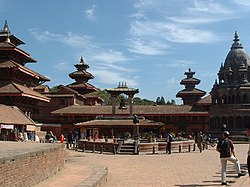[edit] Early ages
PrehistoryNeolithic tools found in the Kathmandu Valley indicate that people have been living there for at least 9,000 years. It appears that people who were probably of Kirant ethnicity lived in Nepal more than 2,500 years ago. The Kirant are a tribe of jungle and mountain people who migrated from various parts of Central Asia, China and the Himalayas.
[edit] Legends and Ancient times
Though very little is known about the early history of Nepal, legends and documented references reach back to the first millennium BCE:- The epic Mahabharata mentions the Kiratas among the inhabitants of Nepal. Kirati king Yalambar had the dubious honor of being slain in the battle of the Mahabharata, in which gods and mortals fought alongside each other. Legend credits him with meeting Indra, the lord of heaven, who ventured into the Valley in human guise. It is said that during the battle of Mahabharata, Yalamber went to witness the battle with a view to take the side of the losing party. Lord Krishna, knowing the intention of Yalamber and the strength and unity of the Kiratas, thought that the war would unnecessarily be prolonged if Yalamber sided with the Kauravas. So, by a clever stroke of diplomacy, Lord Krishna cut off Yalamber's head.
- Also, the presence of historical sites, e.g., Valmiki ashram, indicates the presence of Sanatana (ancient) Hindu culture in parts of modern Nepal at that period.
- According to some legendary accounts in the chronicles, the successors of Ne were the gopālavaṃśi or "Cowherd family", whose names often end in -gupta and are said to have ruled for some 491 years. They are said to have been followed by the mahaiṣapālavaṃśa or "Buffalo-herder Dynasty", established by an Indian Rajput named Bhul Singh.[2]
- In a Licchavi period inscription (found on archeological stoneworks, which list mostly the dates and commissioners of these constructions, also communicate royal edicts, religious mantras or historical notes) mention the Kirata, that through the corroboration of local myths and the Vamsavalis, identify a people prior to the Licchavi dynasty.
[edit] Legendary accounts of the Kirata Period
Nepal's very first recorded, though still legendary, history began with the Kiratis, who may have arrived from the west to the Kathmandu valley. Little is known about them, other than their deftness as sheep farmers and great fondness for carrying long knives. According to the Gopalavamsa chronicle, the Kiratas ruled for about 1225 years (800 BCE-300 CE), their reign had a total of 29 kings during that time. Their first king was Elam; also known as Yalambar, who is referenced in the epic Mahabharata.- The 1st Kirata King Yalambar laid the foundation of the Kirata dynasty after defeating the last ruler of the Abhira dynasty. When Kiraats occupied the valley, they made Matatirtha their capital. The Kirat kingdom during the rule of Yalambar extended to Tista in the East and Trisidi in the West. It is said Yalambar had gone to witness the battle of Mahabharata between the Pandavas and the Kauravas. He was so brave and powerful that Lord Krishna beheaded him prior to the battle suspecting he might fight for the Kauravas.
- The 7th Kirata King 'Jitedasti'
- The 14th Kirata King 'Sthunko'
- The 15th Kirata king 'Jinghri'
- The 28th Kirat King 'Paruka'
- The 29th Kirat King 'Gasti'
